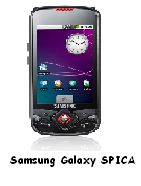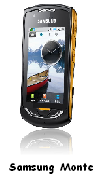
There was a time when we looked up @ a person having a touch screen gadget like multi-millionaire. But things are totally different now. Thanks to LG and Samsung who made this technology reach the lower middle phone segment. Now with lots of touch screen phones around costing little more than 6k, there sure is confusion to choose from.
So in this article I will discuss some of the technologies and terminologies that will help you choose the right touch screen phone according to your requirement.
Touch Screen Types:
Touch screens can be broadly classified as Resistive and Capacitive screens. Each of these technologies has their own pros, cons and purposes. Lets check out how they differ.
Capacitive Touch Screens: The capacitive touch screen is made up of a glass panel that is coated with a material. The property of this material is that it can store electrical charge. So the capacitive touch screens basically stores electrical charge. The human body is a good source for charges to flow. So, when you touch this screen with your finger, some of these charges on the screen get transferred to your finger. The oscillator circuits in the phone will then sense this decrease in the charge on touch screen and the exact location where the touch occurred. And then finally it transfers this specified information to the touch screen driver software, which takes care of the rest.
Pros:
+Highly sensitive to finger touch.
+Multi touch.
+Good sunlight legibility.
Cons:
-Requires little humidity to function smoothly.
-Does not function with objects such as stylus, gloves or even nails.
-It is comparatively costly.
Resistive Touch Screens: Resistive touch screen, on the other hand is again made up of normal glass panel. However, this glass panel in this case is coated with three layers. Two of these layers being conductive and resistive are kept apart using spacers while the third scratch-resistant layer covers the whole setup. When the resistive touch screen system is running, current flows through these layers. On a finger touch, the two layers get connected and change in electrical field occurs. The system calculates the coordinates of point of contact and passes them to touch screen driver software, which takes care of the rest.
Pros:
+Works with any object stylus, pen, nail etc.
+Independent on humidity factor.
+Relatively cheaper
Cons:
-No multi touch support.
-If used with a finger, requires a little bit of pressure to recognize the touch.
-Poor sun light legibility.
-More vulnerable to dust and scratches.
Now that leaves us to choose the technology based on our requirements. If you are going to use hand writing recognition tools (screens are very responsive to stylus) then resistive screens are the best ones for you but remember you will have hard time typing in your hand. On the other hand if you want a device to be very much responsive and you don’t want to use any external objects, then capacitive screens are the ones to go for. As said there is considerable difference in touch sensitivity with capacitive screens beating the resistive screens.
Display types:
TFT LCD/OLED-AMOLED and Super-AMOLED are some of the displays used in mobile phones. Lets have a look at each of the technologies.
TFT LCD (Thin Film Transistor Liquid Crystal Display): This technology uses liquid crystals that have direct driven image elements on which voltage is applied and varied to accomplish different color elements. In addition it uses a back lighting arrangements to illuminate each color element.
Pros:
+ Oldest reliable technology.
Cons:
-Very bad sunlight legibility/ viewing angle.
OLED-AMOLED (Organic Light Emitting Diode/Active Matrix OLED): As the name indicates it uses LED’s to accomplish the task. AMOLED utilizes the Active Matrix addressing with the OLED technology. They are self-illuminating and do not require back lighting. Thus it reduces one more layer on the screen and making it thin. Each of the pixels is self-illuminating thus consuming less battery.
Pros:
+ Less power consumption (since it does not require back lighting).
+ Sharp display with superior brightness, contrast and viewing angle.
+ Faster color switching, reducing ghosting or blurring effects in fast moving graphics, such as action movies or fast moving games.
Cons:
- Poor sun light visibility.
- It is costly.
Here is a good comparison between TFT LCD & AMOLED.
Brightness comparison:


Response time and blurring effects on fast moving objects:

Super AMOLED: Is there a technology that would wipe out the cons of AMOLED? Thanks to Samsung for the Super AMOLED technology, which almost completely eliminates the cons of AMOLED, but for the price tag. Lets hope the cost also comes down. The only change here is that instead of having a separate glass for touch sensor as used in TFT LCD and AMOLED, the AMOLED screen will itself handle the sensor. The following pictures were taken from Mobile World Congress 2010 covered by mobilereview.com, reveals the technology.


Check out the video where Samsung explains its Super AMOLED technology against TFT LCD and AMOLED technologies:
http://www.youtube.com/watch?v=aQkLMG3SBQ4
Here goes the advantages of this technology.
Pros:
+ 20% brighter screen.
+ 80% less sunlight reflection which means good sunlight legibility.
+ 20% more battery life.
Now when we talk about touch screens the first thing that comes to our mind is the iPhone. Now here is the screen comparison between the iPhone (TFT LCD capacitive screen) and Samsung Wave (Super AMOLED with capacitive screen), which is the first phone to have a Super AMOLED screen.


picture source:gsmarena.com
Now this video will sum up as to what to expect from a Super AMOLED screen:
http://www.youtube.com/watch?v=lRkb75gjVD0
Display Resolution: It simply means the physical number of columns and rows of pixels creating the display. More the number of pixels better is the clarity of the display. VGA (Visual Graphics Array) is a standard way of measuring the resolution. VGA refers to a resolution of 640x480. Most of the low-end phones nowadays come with a 2.2” QVGA resolution, which is nothing but Quarter of VGA or a WQVGA. The table will give you an overview of the various display resolutions:

Conclusion:
The Super AMOLED touch screens are a wonderful piece of technology to own. On the other hand TFT LCD’s are tried and tested and one of the most reliable in this front. At the end of the day, no matter how many technologies come up, it all depends on ones requirement and affordability. I hope this article helps you choose the right touch screen phone that meets your requirement and on your budget. Here are some of the phones, with resistive screens:(in the 6k to 15k range)




Here are some of the Capacitive touch screen phones:(in the 9k to 15k range)




7 comments:
highly informative! great work..
when are you going to review Android v2.1? eagerly waiting..
Thank you Jithin.
I will for sure do the review of Android V2.1 very soon.
Feel free to spread a word or two to your friends and the ones who are seeking to know these stuffs.
Show your support by becoming a follower.
Thank you once again.
nice information to share with friends.. i surely will do that..
Thank you very much madhu...
Keep watchin this space for more interesting things to come up!
Dont forget to become a follower :)
very informative. keep it up
thanks.. simple and clear informative article..
thanx friend for this useful information.
Inderjit Singh Japra
Post a Comment